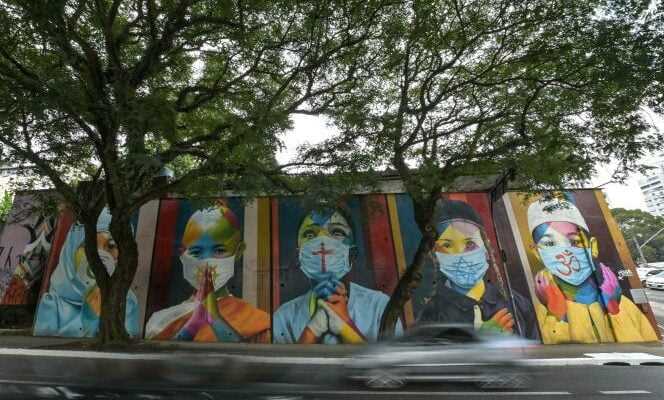LETTER FROM SAO PAULO
Kleber Pagu gets out of the elevator and climbs the last stairs to access the roof of the building. Already equipped with his harness, Mauro Neri revises the sketch of his work: “I was inspired by the drawing of a black child by artist Kadir Nelson. I added a spray can in his hands and the word “Justice” on his face. »
Kleber Pagu is going to see the owners of the building as the producer of the graffiti. He wants to make sure everything is fine: “They are happy, but that’s not always the case. » Mauro Neri climbs the railing “without ever looking down”, and the pulley slowly lowers it. The work justice, lives now adorns a wall of an eight-story building on Augusta Street, 50 meters from Luis Bueno’s collages on two 490-square-meter walls of a 13-story building.
These giant works multiplied during the Covid-19 pandemic and make Sao Paulo a city that can now be visited with your eyes up. On Sundays, the Minhocao viaduct becomes pedestrianized and it is appreciated as much for this space gained over cars as for this graffiti. “I was not very sensitive to this art but I must admit today that it really embellishes the city”, considers Roberto da Vila. This pensioner admires the work of Robinho Santana Algo sober nos which mixes graffiti and pichaçao, a very graphic tag, made of letters and symbols, and which is still considered a crime.
Even if the pichaçao always gets bad press, the graffiti has won the hearts of Paulistas. A new bill introduced by the left proposes to make the city a “open-air art gallery” by sanctifying 30 places already emblematic of graffiti and by promoting urban art.
“Offering protection to works”
“The idea is to facilitate the production of these works and offer them protection. Art must be accessible to those who never go to the museum. But we don’t want culture to be limited to the walls: these 30 places would become free spaces for art and performance.”, explains Kleber Pagu who designed this bill with his wife, the dancer Fernanda Bueno. Councilman Toninho Vespoli, author of the law, says to himself today “certain of its adoption by the municipal council. There is a consensus today on the benefits of graffiti for Sao Paulo”.
On the side of the cultural assistant, the speech is just as benevolent: “Of course we are in favor of it, graffiti is the very identity of Sao Paulo, and we support it. » Aline Torres quotes the achievements financed by the town hall: first the street art museum, created in 2017 and which has 237 works including those of Mauro Neri, Luis Bueno and Robinho Santana. The museum platform allows you to view them in 360 degrees without leaving your home. And this year, the cultural department plans to “graffiti” around thirty tunnels.
You have 48.52% of this article left to read. The following is for subscribers only.
